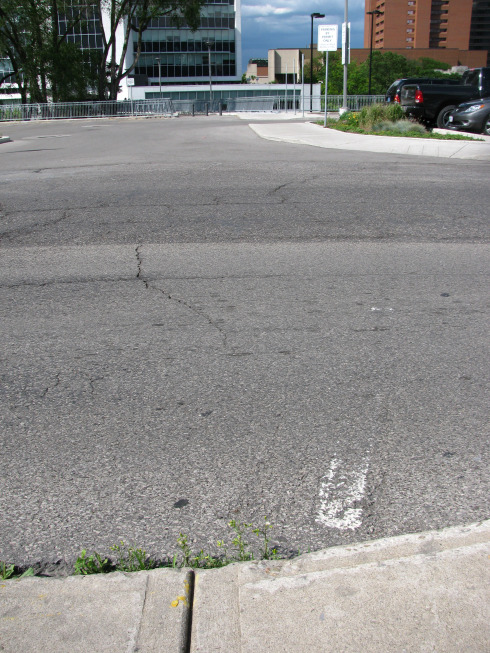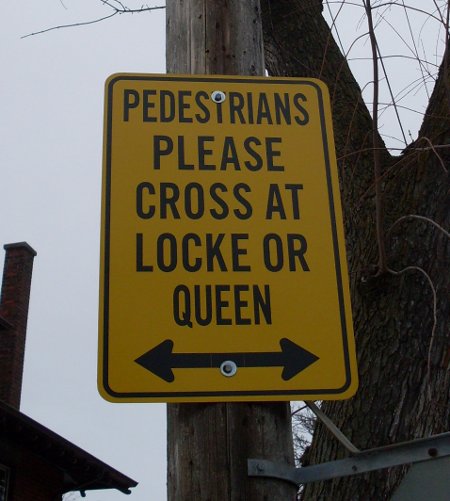The recent RTH article on ghost crosswalks reminded me of the frustration I've had over such a long time trying to get pedestrian improvements.

Ghost crosswalk on Hunter near City Hall (Image Credit: Undustrial)
Perhaps Public Works general manager Gerry Davis would understand why people have given up and are trying playful ways of getting actual improvements at street level if he acknowledged this frustration.
I am reminded of an email I wrote in April 2002 - over 11 years ago - to Andrea Horwath, then our Ward 2 councillor, and the Durand Neighbourhood Association (DNA) about the lack of safe crosswalks.
Despite more than a decade of advocacy, none of these crosswalks has been repaired or restored - but the ghost crosswalks have taken over a decade to fade while Davis refers us to "plans and studies" that he thinks should pacify us.
Back in 2002, the FAQ on the Traffic Department website stated erroneously:
"7. How do I get a crosswalk painted on a street?*
The Highway Traffic Act provides no protection for pedestrians crossing without signal or stop sign protection. Painting lines at locations other than at signals and stop signs, except under very special controlled circumstances, is to be discouraged as it may actually mislead the pedestrian into thinking they have some right of way over traffic. The City currently paints intersections controlled by a traffic signal, a limited number of stop controlled locations, intersections in designated school areas, and locations controlled by an adult crossing guard.
This is simply false. According to the Ontario Highway Traffic Act:
"crosswalk" means,
(a) that part of a highway at an intersection that is included within the connections of the lateral lines of the sidewalks on opposite sides of the highway measured from the curbs or, in the absence of curbs, from the edges of the roadway, or
(b) any portion of a roadway at an intersection or elsewhere distinctly indicated for pedestrian crossing by signs or by lines or other markings on the surface;
In other words, any intersection of two streets, whether marked or not, is a legal crosswalk unless crossing is explicitly prohibited.
Nevertheless, it has been the City's practice to allow painted crosswalks to fade away while removing the associated signage.
Here it the text of my email, sent on April 10, 2002:
Dear Andrea and Durand Neighbourhood Association,
I am writing today because I would like your help in encouraging the Traffic Department to designate more pedestrian crossovers (the technical term for pedestrian crosswalks) in the City of Hamilton, and especially in the Durand neighbourhood.
As noted by the Professor from Ottawa during a Fall meeting on traffic in Durand, Hamilton has very few pedestrian crossovers (apart from those located at traffic lights or stop signs, where motorists must stop anyway). Many major streets in Durand (Hess, Charlton, Queen, Herkimer, Bay) do not have a designated crosswalk for four or five blocks. In fact, I noticed the other day that a crosswalk was actually removed from the corner of Herkimer and Hess!
Furthermore, the very few crossovers that do exist are often only indicated by painted lines, without traffic signs. This makes them extremely dangerous as they are largely invisible to motorists, especially in bad weather. Examples of such non-signposted crossings include the one near the YWCA downtown and on Upper James just South of the escarpment.
At the Durand Traffic study meeting in February I asked Mr Hart Solomon (chief traffic engineer for the City of Hamilton) about the lack of crosswalks, and he said they would like to put more in, but that under the Ontario Highway Act motorists are not required to stop at them!
This seemed ridiculous to me, so I simply looked up the relevant act online and discovered (surprise!) that motorists are indeed required to yield to pedestrians at a crossover. I wrote a message to Mr Solomon back on 25 February citing the relevant sections of the Ontario Highway Act, and asked him to explain why he refuses to designate pedestrian crossovers (please see the email at the end of this message). I still have not received a response.
The Durand Traffic Study is an excellent initiative, but if the Traffic Department is planning to block any additional crosswalks its impact will be limited. I would be very grateful for your help in determing why the Traffic Department refuses to designate crossovers, and in encouraging them to change their policy. It may also be appropriate to contact the consultants involved in the Durand Traffic Study regarding this issue.
Please do not hesitate to contact me if you have further questions.
Yours sincerely,
Nicholas Kevlahan
I did eventually get a response from Hart Solomon, written three months after my original February 2002 email to him. He wrote:
Sir,
As per our discussion, I have reviewed the Highway Traffic Act requirements for a Pedestrian Crossover.
As I suggested, Sections 20.1 through 20.6 of Regulation 615 describe the signs and pavement markings mandated, which include ground-mounted signs, overhead internally-illuminated signs and flashing amber beacons actuated by a pushbutton. The same information is repeated in sections A6.01 through A6.13 of the Ontario Manual of Uniform Traffic Control. It is not sufficient just to paint lines across the road, and this understanding has been confirmed by the City's legal counsel.
Hope this helps.
Hart Solomon, P.Eng
Manager of Traffic Engineering and Operations
Solomon, who has since retired, later told me personally about removing the signs and letting the painted lines fade as a way of avoiding liability for the city.
What his letter makes clear is that the City's main concern is not actually safety for pedestrians, but perceived liability. For over ten years, the City has been willing to put pedestrians at risk as the crosswalk markings have faded, and has abdicated any responsibility to respond to the needs of pedestrians.
The infamous yellow warning signs in Kirkendall were an inevitable result of this way of thinking:

Former sign at Aberdeen and Kent: 'PEDESTRIANS PLEASE CROSS AT LOCKE OR QUEEN'
In light of this long, frustrating history, the actions of tactical urbanism start to make a lot more sense.
By movedtohamilton (registered) | Posted May 13, 2013 at 13:01:44
Hamilton specializes in pretzel logic. It's been elevated to the highest status. The City have listened to Steely Dan over and over again.
Like I wrote in comments section of "Ghost Crosswalks...", the City Solicitor must get involved.
By Noted (anonymous) | Posted May 13, 2013 at 13:13:16 in reply to Comment 88689
"They say the times are changing but I just don't know/
These things are gone forever/
Over a long time ago..."
By Gary Santucci (anonymous) | Posted May 13, 2013 at 19:23:05
Ode to Hart Solomon by AC/DC
Living easy, living free
Season ticket on a one-way ride
Asking nothing, leave me be
Taking everything in my stride
Don't need reason, don't need rhyme
Ain't nothing I would rather do
Going down, party time
My friends are gonna be there too
I'm on the highway to hell
No stop signs, speed limit
Nobody's gonna slow me down
Like a wheel, gonna spin it
Nobody's gonna mess me round
Hey Satan, payed my dues
Playing in a rocking band
Hey Momma, look at me
I'm on my way to the promised land
I'm on the highway to hell
(Don't stop me)
And I'm going down, all the way down
I'm on the highway to hell
By Robert D (anonymous) | Posted May 13, 2013 at 23:10:46
I'm not sure I follow your logic here:
"(b) any portion of a roadway at an intersection or elsewhere distinctly indicated for pedestrian crossing by signs or by lines or other markings on the surface;
In other words, any intersection of two streets, whether marked or not, is a legal crosswalk unless crossing is explicitly prohibited."
You seem to be reading (b) to say that a crosswalk is any portion of a roadway at an intersection, or elsewhere distinctly indicated (note the placement of the comma).
Personally, in the absence of a comma in the legislation, I would read (b) to say a crosswalk is any portion of the roadway distinctly indicated for pedestrian crossing (whether at an intersection or elsewhere).
I certainly don't agree with the City that painting lines affords no protection, in fact the act seems to explicitly state otherwise. But I'm not sure I would interpret the HTA the same way you have.
Do you happen to know if there is jurisprudence supporting either your interpretation or mine? The structure of the sentence does not make its meaning entirely clear.
By RobertD (anonymous) | Posted May 14, 2013 at 09:45:34 in reply to Comment 88710
No, I saw it, but took the "common" meaning of highway. Whereas I now see the definition in the highway traffic act more broadly seems to include all roads.
You must be logged in to comment.
There are no upcoming events right now.
Why not post one?